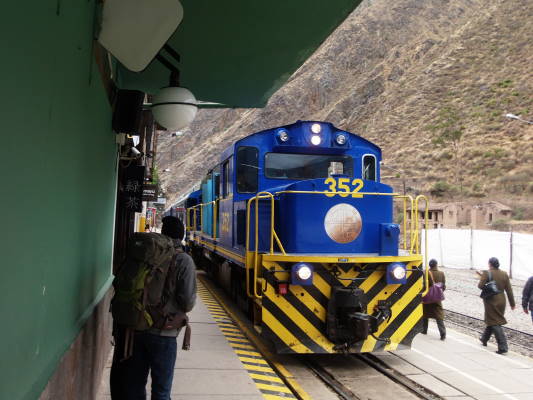Although we had a ticket for a second day to visit Machu Picchu, this turned out literally to be a washout. We sat out five hours of torrential downpour in the bus shelter, after which we decided it wasn't worth it and returned to the village. The entrance to Machu Picchu was a sea of colourful "plásticos", ponchos of many colours sold by locals to the desperate tourists, wondering whether or not to try their luck.
2.Tag Machu Picchu: Regen, Regen, Regen. Wir haben fünf Stunden auf Wetterbesserung gewartet. Nachdem wir schon am Vortag unser alles besichtigt haben sind wir nach Aguas Calientes zurück gefahren.
Die Peruaner haben auf die Wetterlage rasch reagiert und mit Regenschutz gutes Geschäft gemacht.
Village square, Aguas Calientes, alias "Machu Picchu Village"
Hauptplatz Aguas Calientes
The railway goes through the middle of the village
Der Zug fährt mitten durch den Ort
Inside of restaurant, with railway instead of road outside
Beim Verlassen des Lokals links und rechts schauen
Restaurants don't always have windows or doors in Peru. View from the back balcony (open)
Ausblick aus Restaurant (kein Fenster bei ca 12°)
The path to the railway platform had to be negotiated through a gigantic bazaar
Der Bahnhof ist nur durch einen Basar erreichbar.
En route to Cusco by rail
Bilder von der Zugfahrt durchs Urumbamatal nach Cusco
Arrival at hotel in Cusco
Endlich unser Hotel in Cusco
.JPG)
.JPG)
.JPG)
.JPG)
.JPG)
.JPG)





.JPG)
.JPG)
.JPG)
.JPG)



















.JPG)









.JPG)
.JPG)
.JPG)
.JPG)
.JPG)
.JPG)
.JPG)






